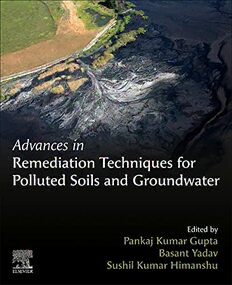
Advances in Remediation Techniques for Polluted Soils and Groundwater PDF
Preview Advances in Remediation Techniques for Polluted Soils and Groundwater
Advances in Remediation Techniques for Polluted Soils and Groundwater This pageintentionallyleftblank Advances in Remediation Techniques for Polluted Soils and Groundwater Edited by Pankaj Kumar Gupta Wetland Hydrology Research Laboratory, Faculty of Environment, University of Waterloo, Waterloo, ON, Canada Basant Yadav Department of Water Resources Development and Management (WRD&M), Indian Institute of Technology Roorkee, Uttarakhand, India Sushil Kumar Himanshu Department of Food, Agriculture and Bioresources, School of Environment, Resources and Development, Asian Institute of Technology, Pathum Thani, Thailand Elsevier Radarweg29,POBox211,1000AEAmsterdam,Netherlands TheBoulevard,LangfordLane,Kidlington,OxfordOX51GB,UnitedKingdom 50HampshireStreet,5thFloor,Cambridge,MA02139,UnitedStates Copyright©2022ElsevierInc.Allrightsreserved. Nopartofthispublicationmaybereproducedortransmittedinanyformorbyanymeans,electronicormechanical, includingphotocopying,recording,oranyinformationstorageandretrievalsystem,withoutpermissioninwriting fromthepublisher.Detailsonhowtoseekpermission,furtherinformationaboutthePublisher’spermissionspolicies andourarrangementswithorganizationssuchastheCopyrightClearanceCenterandtheCopyrightLicensingAgency, canbefoundatourwebsite:www.elsevier.com/permissions. ThisbookandtheindividualcontributionscontainedinitareprotectedundercopyrightbythePublisher(otherthan asmaybenotedherein). Notices Knowledgeandbestpracticeinthisfieldareconstantlychanging.Asnewresearchandexperiencebroadenourunder- standing,changesinresearchmethods,professionalpractices,ormedicaltreatmentmaybecomenecessary. Practitionersandresearchersmustalwaysrelyontheirownexperienceandknowledgeinevaluatingandusingany information,methods,compounds,orexperimentsdescribedherein.Inusingsuchinformationormethodsthey shouldbemindfuloftheirownsafetyandthesafetyofothers,includingpartiesforwhomtheyhaveaprofessional responsibility. Tothefullestextentofthelaw,neitherthePublishernortheauthors,contributors,oreditors,assumeanyliabilityfor anyinjuryand/ordamagetopersonsorpropertyasamatterofproductsliability,negligenceorotherwise,orfromany useoroperationofanymethods,products,instructions,orideascontainedinthematerialherein. BritishLibraryCataloguing-in-PublicationData AcataloguerecordforthisbookisavailablefromtheBritishLibrary LibraryofCongressCataloging-in-PublicationData AcatalogrecordforthisbookisavailablefromtheLibraryofCongress ISBN:978-0-12-823830-1 ForInformationonallElsevierpublications visitourwebsiteathttps://www.elsevier.com/books-and-journals Publisher:SusanDennis AcquisitionsEditor:AnitaA.Koch EditorialProjectManager:JudithClarissePunzalan ProductionProjectManager:SujathaThirugnanaSambandam CoverDesigner:MatthewLimbert TypesetbyMPSLimited,Chennai,India Contents LIST OF CONTRIBUTORS............................................................................xi ABOUT THE EDITORS.................................................................................xv CHAPTER1 Flowandmovementofgaseouspollutantsinthesubsurface: CO dynamicsatacarboncaptureandstoragesite......................1 2 Shachi and Anuradha Garg 1.1 Introduction.....................................................................................1 1.2 WorldwideCO storageprojects...................................................2 2 1.3 GaseousCO inthesubsurface....................................................3 2 1.4 FactorsaffectingCO migrationinthesubsurface.....................6 2 1.5 CO (cid:1)brine(cid:1)rockinteractioninthesubsurface..........................8 2 1.6 PotentialriskassociatedwithCO leakage...............................10 2 1.7 NumericalmodelingforinvestigatingCO dynamics...............11 2 1.8 ModelingofCO insubsurface:acasestudy............................12 2 1.9 Conclusionsandfutureprospective...........................................14 Acknowledgments..................................................................................15 References............................................................................................15 CHAPTER2 Column adsorption studiesfor the removalof chemical oxygendemand from fish pond wastewater using waste alum sludge.....................................................................21 Muibat D. Yahya, Ibrahim A. Imam and Saka A. Abdulkareem 2.1 Introduction...................................................................................21 2.2 Materialsandmethods................................................................23 2.3 Resultsanddiscussion................................................................29 2.4 Conclusion....................................................................................43 References............................................................................................44 CHAPTER3 Farmmanagementpracticesforwaterqualityimprovement: economicriskanalysisofwinterwheatproductioninthe SouthernHighPlains..........................................................................49 Yubing Fan and Sushil KumarHimanshu 3.1 Introduction...................................................................................49 3.2 Data...............................................................................................50 v vi Contents 3.3 Methods.........................................................................................53 3.4 Resultsanddiscussion................................................................56 3.5 Conclusion....................................................................................61 AppendixA..............................................................................................62 References............................................................................................64 CHAPTER4 Bioremediation ofcontaminatedsoilsby bacterial biosurfactants.............................................................................67 SabahFatima, Muzafar Zaman,Basharat Hamid, FaheemBashir,Zahoor AhmadBabaand Tahir Ahmad Sheikh 4.1 Introduction...................................................................................67 4.2 Bacterialbiosurfactantsandtheirclassification.......................68 4.3 Roleofbacterialbiosurfactantsinthebioremediation ofcontaminatedsoils...................................................................70 4.4 Conclusionandfutureprospectus..............................................78 References............................................................................................79 CHAPTER5 Evaluationofmachinelearning-basedmodeling approachesingroundwaterquantityandqualityprediction.......87 Madhumita Sahoo 5.1 Overview........................................................................................87 5.2 PopularMltechniquesusedingroundwatermodeling............91 5.3 EfficacyofML-basedmodeling...................................................93 5.4 Conclusion....................................................................................96 References............................................................................................97 CHAPTER6 Microbial consortium for bioremediation of polycyclic aromatic hydrocarbons polluted sites....................................105 PankajKumarGupta 6.1 Introduction.................................................................................105 6.2 PAHspollutants:source,toxicity,andmetabolicpathways........106 6.3 BioremediationofPAHs............................................................107 6.4 Plant(cid:1)microbesinteractions....................................................111 6.5 MicrobesandtheirconsortiumtodegradePAHs...................113 6.6 Microbialdegradationkineticsmodels....................................116 6.7 Conclusionandfuturerecommendations................................117 Acknowledgments................................................................................118 References..........................................................................................118 CHAPTER7 Fate, transport, and bioremediationof PAHs in experimental domain:an overview of current status and future prospects.......................................................................125 PankajKumarGupta,Manik Goel,SanjayK. Gupta and Ram N. Bhargava 7.1 Introduction.................................................................................125 Contents vii 7.2 PAHsfateandtransportmechanisms.....................................127 7.3 StudiesinvestigatedPAHsbehaviorsinlaboratorydomain........128 7.4 PolishingPAH-pollutedsiteusingsubsurface-constructed wetlands..............................................................................................131 7.5 Conclusiveremarkandfutureprospects.................................135 References..........................................................................................136 CHAPTER8 Mathematical modeling of contaminant transport in the subsurfaceenvironment...............................................141 Abhay Guleriaand Sumedha Chakma 8.1 Introduction.................................................................................141 8.2 Contaminanttransportmodelsforsaturated porousmedia..............................................................................143 8.3 Categorizationofmathematicalmodelingstudies relatedtoIndiangroundwaterandsoilsystems.....................148 8.4 Contaminanttransportmodelinginthesubsurface environmentusingmobile(cid:1)immobilemodel..........................158 8.5 Conclusionandfuturedirections..............................................163 Acknowledgment.................................................................................164 References..........................................................................................164 CHAPTER9 Impactsof climatic variabilityon subsurface water resources..................................................................................171 Pankaj Kumar Gupta, BrijeshKumarYadav and Devesh Sharma 9.1 Introduction.................................................................................171 9.2 Impactsonatmosphericboundary...........................................173 9.3 Impactsonwaterstorageandflowpattern.............................175 9.4 Impactsonground(cid:1)surfacewaterinteractions......................177 9.5 Impactsonsubsurfacewaterquality.......................................178 9.6 Methodologicalframeworkforevaluatingclimate changeimpactsonsubsurface.................................................182 9.7 Conclusionandrecommendations...........................................183 Acknowledgment.................................................................................184 References..........................................................................................185 CHAPTER10 Microplastic in the subsurface system: Extraction and characterization from sediments ofRiverGanga near Patna,Bihar...................................................................191 Rashmi Singh, Rakesh Kumar and Prabhakar Sharma 10.1 Introduction............................................................................191 10.2 Materialsandmethod...........................................................199 10.3 Resultsanddiscussion..........................................................203 10.4 Conclusion..............................................................................212 References........................................................................................213 viii Contents CHAPTER11 Assessment oflong-term groundwater variation in India using GLDAS reanalysis...........................................219 SwatantraKumarDubey,PreetLal,PandurangChoudhari, AdityaSharmaandAdityaKumarDubey 11.1 Introduction............................................................................219 11.2 Datausedandmethodology..................................................221 11.3 Resultsanddiscussion..........................................................223 11.4 Conclusion..............................................................................229 References........................................................................................230 CHAPTER12 Emerging contaminants in subsurface: sources, remediation, and challenges.................................................233 Anuradha Garg and Shachi 12.1 Introduction............................................................................233 12.2 Sourcesofemergingcontaminantsingroundwater..........234 12.3 Detectionandanalysis...........................................................237 12.4 Typesofemergingcontaminants.........................................238 12.5 Fateofemergingcontaminantsingroundwater.................240 12.6 Potentialrisksassociatedwithemerging contaminants..........................................................................242 12.7 Remediationofemergingcontaminants..............................244 12.8 Challengesandscope...........................................................246 12.9 Discussionandconclusion....................................................247 References........................................................................................247 CHAPTER13 Selenium and naturally occurring radioactive contaminants in soil(cid:1)water systems...................................259 PankajKumarGupta,GauravSaxenaandBasantYadav 13.1 Introduction............................................................................259 13.2 Selenium:distributioninIndiansoil(cid:1)watersystems.........260 13.3 Naturallyoccurringradioactivematerial: distributioninIndiansoil(cid:1)watersystems...........................261 13.4 Remedialmeasures...............................................................262 13.5 Fieldscaleimplicationsandfutureresearch......................264 References........................................................................................264 CHAPTER14 Understanding and modeling the processof seawater intrusion: areview.................................................................269 Lingaraj Dhaland SabyasachiSwain 14.1 Background............................................................................269 14.2 Seawaterintrusionprocess..................................................270 14.3 Measurementandmonitoringofseawaterintrusion.........276 14.4 Seawaterintrusionmodelingandprediction......................278 14.5 Managementofseawaterintrusion......................................280 14.6 Seawaterintrusion,climatechange,andsealevelrise.........282 14.7 Conclusion..............................................................................283 References........................................................................................283 Contents ix CHAPTER15 Prioritizationof erosionprone areas based on asediment yield index forconservation treatments: Acase study ofthe upperTapiRiverbasin.........................291 SantoshS. Palmate, Kumar Amrit, Vikas G. Jadhao, Deen Dayal and Sushil KumarHimanshu 15.1 Introduction............................................................................291 15.2 Studyarea...............................................................................293 15.3 Dataused................................................................................293 15.4 Methodology...........................................................................298 15.5 Resultsanddiscussion..........................................................301 15.6 Summaryandconclusions....................................................305 References........................................................................................306 CHAPTER16 Advances in hydrocarbon bioremediation products: natural solutions....................................................................309 PankajKumarGupta 16.1 Introduction............................................................................309 16.2 Engineeredconstructedwetlands........................................310 16.3 Nativeandspecializedmicrobialcommunities...................312 16.4 Biodieselsasbiostimulators.................................................313 16.5 Phycoremediation..................................................................315 References........................................................................................315 CHAPTER17 Nitrate-Nmovement revealed by a controlled in situ solute injection experiment in the middle Gangetic plains of India.........................................................................319 PankajKumarGupta,Basant Yadav, KristellLe Corre and Alison Parker 17.1 Introduction............................................................................319 17.2 Studysite................................................................................321 17.3 Methodology...........................................................................324 17.4 Resultsanddiscussion..........................................................325 17.5 Conclusion..............................................................................332 CRediTauthorshipcontributionstatement.....................................332 Conflictsofinterest...........................................................................332 Acknowledgment...............................................................................333 Dataavailability..................................................................................333 References........................................................................................333 CHAPTER18 Integrated water resources management in Sikta irrigationsystem, Nepal..............................................337 Rituraj Shukla, IshwariTiwari, DeepakKhare and RameshP. Rudra 18.1 Introduction............................................................................337 18.2 Studyarea...............................................................................338
